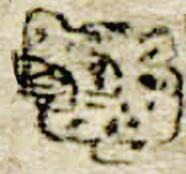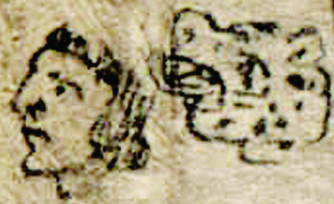Ocelotl (BMapG33)
This black-line drawing of the simplex glyph for the personal name Ocelotl (“Jaguar”) shows the head of the animal in profile, facing left, toward the man whose name this was. The ocelotl head has spots and small ears. Its mouth is open, with teeth and tongue visible.
Stephanie Wood
Ocelotl was a name from the 260-day religious divinatory calendar, the tonalpohualli.
Stephanie Wood
This glyph is not glossed; the transliteration of the glyph comes from Gordon Whittaker’s contribution to the study by Mary E. Miller and Barbara E. Mundy (2012).
c. 1565
Jeff Haskett-Wood
jaguares, animales feroces, calendarios, nombres de días, nombres de hombres

ocelo(tl), jaguar, https://nahuatl.wired-humanities.org/content/ocelotl
Jaguar
Stephanie Wood
Beinecke Map/Codex Reese, section 8, no. 433 in the Whittaker study (published in the Miller/Mundy book, 2012), and see the original at: https://brbl-dl.library.yale.edu/vufind/Record/3600017
The Bodleian Libraries, University of Oxford, hold the original manuscript, the MS. Arch. Selden. A. 1. This image is published here under the UK Creative Commons, “Attribution-NonCommercial-ShareAlike 3.0 License” (CC-BY-NC-SA 3.0).






